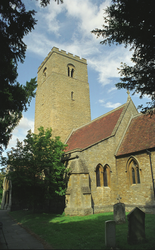
The Corpus of ROMANESQUE SCULPTURE in Britain & Ireland

St Thomas of Canterbury (now)
Parish church
Mumby is a village in the East Lindsey district of Lincolnshire, 33 miles E of Lincoln and 2½ miles from the North Sea coast at Chapel St Leonard's. The church is on the main road through the village and is built of limestone ashlar, squared limestone and greenstone rubble. It consists of a 13thc. nave with clerestoreys and four-bay side aisles. The three W bays of the N arcade have transitional piers and responds of Romanesque style. The W tower is in a Perpendicular style. The church was restored in 1843-4; the long chancel being rebuilt in 1874.
Parish church
The village of Elsfield is located on a rural escarpment 3 miles NE of Oxford, outside the ring road. A church existed here by 1122, or perhaps earlier. The present church of St Thomas of Canterbury now comprises a chancel, nave with S porch, and a 19thc bellcote on the W gable. It was largely rebuilt in the 13thc. There was once a N aisle, whose blocked arches were visible in the N wall until restorations of 1849 and 1859. The earliest surviving Romanesque feature is the chancel arch of c. 1170-80, with high quality decorated responds. There is also a plain Romanesque font.
Parish church
Cothelstone is a small village five miles NW of Taunton, consisting of the church, the manor farm and a few dwellings built along a lane off the road running N out of Bishops Lydeard. The church is of red sandstone with limestone & hamstone dressings, and has a 2-bay nave with a S aisle & porch, a chancel with a N vestry and a W tower. It is chiefly 15thc, and was restored c.1864, but the S arcade incorporates a 12thc pier and a corbel of c.1200.
Parish church
The church comprises an aisleless nave, chancel and W tower with a
memorial chapel attached to the chancel on the N, and the vestry attached to
the nave on the N. In the 12thc. the church consisted of an aisleless nave and
chancel. The W tower was added in the 15thc. and the Lytton chapel, which abuts
the chancel, was added in the 16thc. The E and S walls of the chancel were
rebuilt in the 19thc. by Edwin Lutyens. The vestry on the N side of the nave is 19thc. and the attached
kitchen and utility rooms are 20thc. A plain, blocked 12thc. window with
roll -moulded jambs survives in the N wall of the chancel. A S doorway to the
chancel and two flanking round-headed windows were replaced in Lutyen’s
restoration. Simple sculpture survives on the chancel arch and on a section of
cross-shaft reused as a quoin stone on the SE angle of the chancel. Much of the
original walling has been rendered, although a small section on the N wall of
the nave (W end) has the original flint walling exposed. The tower is of flint
as are the 19th and 20thc. alterations. Lutyen’s walling is of knapped
flint. The church is located in the grounds of Knebworth House.
Parish church
The church has chancel, nave with N and S aisles and S porch, and a W tower. A vestry abuts the tower and the N aisle. The tower is late 12thc. and has a plain round-headed window in the S wall on the first stage and two others on the N and S faces of the second stage. There is a pointed tower arch. This is featureless apart from hollow-chamfered imposts with a groove along the upright. There is a late 12thc or early 13thc. W doorway and a 12thc. font. The rest of the church is 15thc. and 16thc. It was restored in 1885 by Fulford of Exeter (Historic England listing: 1147443). It is built of red sandstone ashlar except the tower which is of shale rubble. The W doorway and the font are the only features with Romanesque sculpture.
Parish church
The church has chancel, nave with N and S aisles and W tower. The
tower is substantially late 11thc. to early 12thc. and is wider than the nave. It has a
plain segmental-headed W doorway, which may be of later date and a plain round-headed
arch to the nave. The plain chancel arch and part of the chancel walls are 12thc. Two of the three bays of the N and S nave arcades are 13thc. and the
remaining bay is of 1861. The chancel is
of 1862-3 by G.G. Scott. Simple late 11th to early 12thc. sculpture is found on the
bell-openings.





